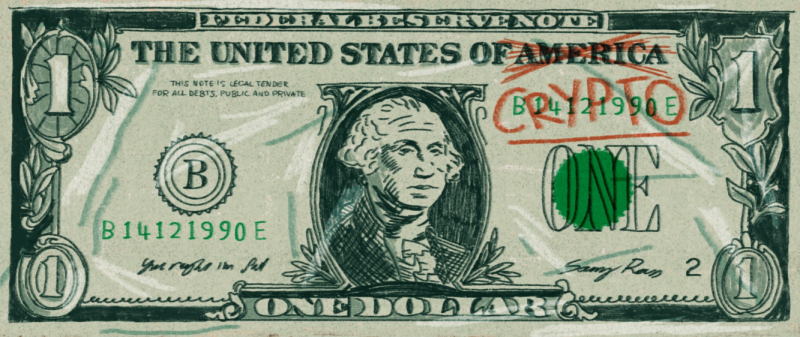Summary of the Fed’s report on a potential American Central Bank currency

We publish here a summary of the report entitled Money and payments: the U.S Dollar in the age of digital transformation published by the Federal Reserve this month. This official publication will be analysed in the February edition of the GEAB (No 162): E-U$D: the Fed and the U.S. will wait… or it may be too late.
The paper is not intended to advance any specific policy outcome, nor is it intended to signal that the Federal Reserve will make any imminent decisions about the opportunity of issuing a U.S. CBDC.
Federal Reserve policymakers and staff have studied CBDC closely for several years, guided by an understanding that any U.S. CBDC should, among other things:
- provide benefits to households, businesses, and the overall economy that exceed any costs and risks;
- yield such benefits more effectively than alternative methods;
- complement, rather than replace, current forms of money and methods for providing financial services;
- protect consumer privacy;
- protect against criminal activity;
- have broad support from key stakeholders.
The Federal Reserve’s initial analysis suggests that a potential U.S. CBDC, if one were created, would best serve the needs of the United States by being privacy-protected, intermediated, widely transferable, and identity-verified. As noted above, however, the paper is not intended to advance a specific policy outcome and takes no position on the ultimate desirability of a U.S. CBDC.
While Americans have long held money predominantly in digital Form […] a CBDC would differ from existing digital money available to the general public because a CBDC would be a liability of the Federal Reserve, not of a commercial bank.
A CBDC could potentially offer a range of benefits. For example, it could provide households and businesses a convenient, electronic form of central bank money, with the safety and liquidity that would entail; give entrepreneurs a platform on which to create new financial products and services; support faster and cheaper payments (including cross-border payments); and expand consumer access to the financial system. A CBDC could also pose certain risks and would raise a variety of important policy questions, including how it might affect financial-sector market structure, the cost and availability of credit, the safety and stability of the financial system, and the efficacy of monetary policy.
The Federal Reserve does not intend to proceed with issuance of a CBDC without clear support from the executive branch and from Congress, ideally in the form of a specific authorising law.
The Federal Reserve is also building a new interbank settlement service for instant payments, the FedNow Service, scheduled to be effective in 2023. These instant payment services will enable commercial banks to provide payment services to households and businesses around the clock, every day of the year, with recipients gaining immediate access to transferred funds. The growth of these instant payment services also could reduce the costs and fees associated with certain types of payments.
In addition, a host of consumer-focused services that are accessible through mobile devices have made digital payments faster and more convenient. Some of these new payment services, however, could pose financial stability, payment system integrity, and other risks. For example, if the growth of nonbank payment services were to cause a large-scale shift of money from commercial banks to nonbanks, the resulting lack of equivalent protections that come with commercial bank money could bring in risks or other instabilities to the financial system.
A crucial test for a potential CBDC is whether it would prove superior to other methods that might address issues of concern outlined in this paper. As a liability of the Federal Reserve, however, a CBDC would not require mechanisms like deposit insurance to maintain public confidence, nor would a CBDC depend on backing by an underlying asset pool to maintain its value. A CBDC would be the safest digital asset available to the general public, with no associated credit or liquidity risk.
An intermediated model would facilitate the use of the private sector’s existing privacy and identity-management frameworks; leverage the private sector’s ability to innovate; and reduce the prospects for destabilising disruptions to the well-functioning U.S. financial system.
A CBDC could potentially serve as a new foundation for the payment system and a bridge between different payment services, both legacy and new. It could also maintain the centrality of safe and trusted central bank money in a rapidly digitizing economy. Another potential benefit of a U.S.-issued CBDC could be to preserve the dominant international role of the U.S. dollar. […] The dollar’s international role benefits the United States by, among other things, lowering transaction and borrowing costs for U.S. households, businesses, and government. The dollar’s international role also allows the United States to influence standards for the global monetary system.
It is important, however, to consider the implications of a potential future state in which many foreign countries and currency unions may have introduced CBDCs. Some have suggested that, if these new CBDCs were more attractive than existing forms of the U.S. dollar, global use of the dollar could decrease—and a U.S. CBDC might help preserve the international role of the dollar.
In some jurisdictions, however, digital payments have rapidly supplanted cash. While cash use in the United States fell from 40 percent of transactions in 2012 (12 percent by value) to 19 percent in 2020, other countries have seen more rapid declines […] If these trends were to emerge in the United States, consumers might want the option of digitized central bank money that, like cash, would have no credit or liquidity risk attached to it.



Comments